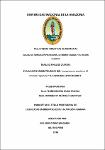Evaluación bromatológica del Lycopersicum esculenta M. (tomate regional) y su capacidad antioxidante.

View/
Date
2016Author
Flores García, Saida Fabiola
Hernández Reátegui, Candy Sue
Metadata
Show full item recordAbstract
El Lycopersicum esculenta M. más conocido como tomate regional es una variedad que se desarrolla en la Amazonía peruana, tiene ciertas características en su contextura (forma, color y sabor), que la hacen diferente visiblemente frente a otros tomates. En los laboratorios se emplearon distintos métodos clásicos y fórmulas establecidas para estos tipos de análisis como la determinación de humedad (94.16%), cenizas (0.54%), grasas (0.32%), proteínas (0.72%), carbohidratos (4.26%), energía (22.8Kcal/100g), pH (5.3), fibra (1.99%), azúcares reductores (0.2 mg/100g), acidez titulable (0.42%) y sólidos totales (5.84%); empleando un espectrofotómetro se determinó la actividad antioxidante (AA) mediante la prueba del DPPH y el contenido de fenoles totales (21.85 ± 0.035mg EAG/100g de muestra original), antocianinas (0.08±0.55mg de cianidina-3-glucosido/100g de muestra original), flavonoides (48.57 g de quercetina/100g muestra original), taninos (181mg (+)-catequina/100g de muestra original,), y la presencia de β – caroteno (0.32mg/100 gr de muestra original) y retinol (1.84mg/100 gr de muestra original) se utilizó muestra fresca de Lycopersicum esculenta M. tomate regional. Se obtuvieron resultados congruentes con el estándar de resultados en investigaciones con tomates de otras variedades y lugares. The Lycopersicum esculenta M. known as regional tomato is a variety that develops in the Peruvian Amazon, has certain characteristics in its texture (shape, color and flavor), making it visibly different compared to other tomatoes. In laboratories different classical methods and established formulas for these types of analysis and determination of moisture (94.16%), ash (0.54%), fat (0.32%), protein (0.72%), carbohydrates (4.26%) were used, energy (22.8Kcal / 100g), pH (5.3), fiber (1.99%), reducing sugars (0.2 mg / 100g), solid titratable acidity (0.42%) and total solids(5.84%); using a spectrophotometer antioxidant activity (AA) it was determined by DPPH test and total phenol content (21.85 ± EAG 0.035mg / 100g original sample), anthocyanins (0.08 ± 0.55mg cyanidin-3-glucoside / 100g Original) shows, flavonoids (quercetin 48.57 g / 100g original sample), tannins (181mg (+) - catechin / 100g original sample), and the presence of β - carotene (0.32mg / 100g original sample) and retinol (1.84mg / 100 g original sample) sample fresh regional tomato Lycopersicum M. esculenta was used. consistent with the standard of research results with other varieties of tomatoes and places results were obtained.
Collections
- Tesis [189]
The following license files are associated with this item:

